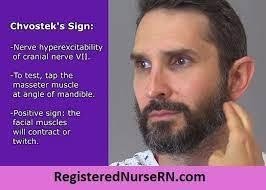A nurse is collecting data from a client who has an NG tube set to low intermittent suction. Which of the following findings indicates hypomagnesemia?
Bone pain
Drowsiness
Bowel hypomotility
Positive Chvostek's sign
The Correct Answer is D
A. Bone pain: Bone pain is not a characteristic finding of hypomagnesemia. Hypomagnesemia is an electrolyte imbalance, and bone pain is not a typical symptom associated with it.
B. Drowsiness: Drowsiness may occur in hypomagnesemia, but it is not a specific or characteristic sign of this condition. Other electrolyte imbalances and medical conditions can also cause drowsiness.
C. Bowel hypomotility: Hypomagnesemia can cause bowel hypomotility (decreased bowel movements), but it is not the most specific finding associated with this condition.
D. Positive Chvostek's sign: Correct. Hypomagnesemia can lead to neuromuscular irritability, and a positive Chvostek's sign is a clinical manifestation of this condition. A positive Chvostek's sign is elicited by tapping the facial nerve (at the level of the zygomatic arch) and observing a
twitching of the facial muscles, which indicates increased neuromuscular excitability.

Nursing Test Bank
Naxlex Comprehensive Predictor Exams
Related Questions
Correct Answer is C
Explanation
A. Place the client's medication record on the bedside table while ambulating the client: This action does not relate to protecting the client's privacy. It might actually compromise confidentiality by leaving sensitive information exposed.
B. Give a report about the client's status while standing at the nurses' station: This action does not protect the client's privacy. Discussing sensitive information in a public area can lead to breaches of confidentiality.
C. Speak with the client about their condition after visitors have left: Correct. Protecting the client's privacy is essential, and discussing personal health information in private with the client respects their right to confidentiality.
D. Place a message board in the client's room to post dietary information: This action does not relate to protecting the client's privacy. Posting dietary information may be helpful for staff, but it doesn't address the client's privacy concerns.
Correct Answer is A
Explanation
A. Precontemplation
According to evidence-based practice, the nurse should identify that precontemplation is the first stage the client will experience when using the stages of health behavior change. In this stage,
the client avoids discussing the behavior and does not intend to make a change in behavior. The stages of health behavior change are pre contemplation, contemplation, preparation, action and the maintenance stage
B. Preparation INCORRECT
The nurse should identify that preparation is the third stage the client will experience when using the stages of health behavior change. In this stage, the client plans to make minor changes to behavior. However, according to evidence-based practice, another stage occurs prior to the preparation stage.
Whether you are a student looking to ace your exams or a practicing nurse seeking to enhance your expertise , our nursing education contents will empower you with the confidence and competence to make a difference in the lives of patients and become a respected leader in the healthcare field.
Visit Naxlex, invest in your future and unlock endless possibilities with our unparalleled nursing education contents today
Report Wrong Answer on the Current Question
Do you disagree with the answer? If yes, what is your expected answer? Explain.
Kindly be descriptive with the issue you are facing.
